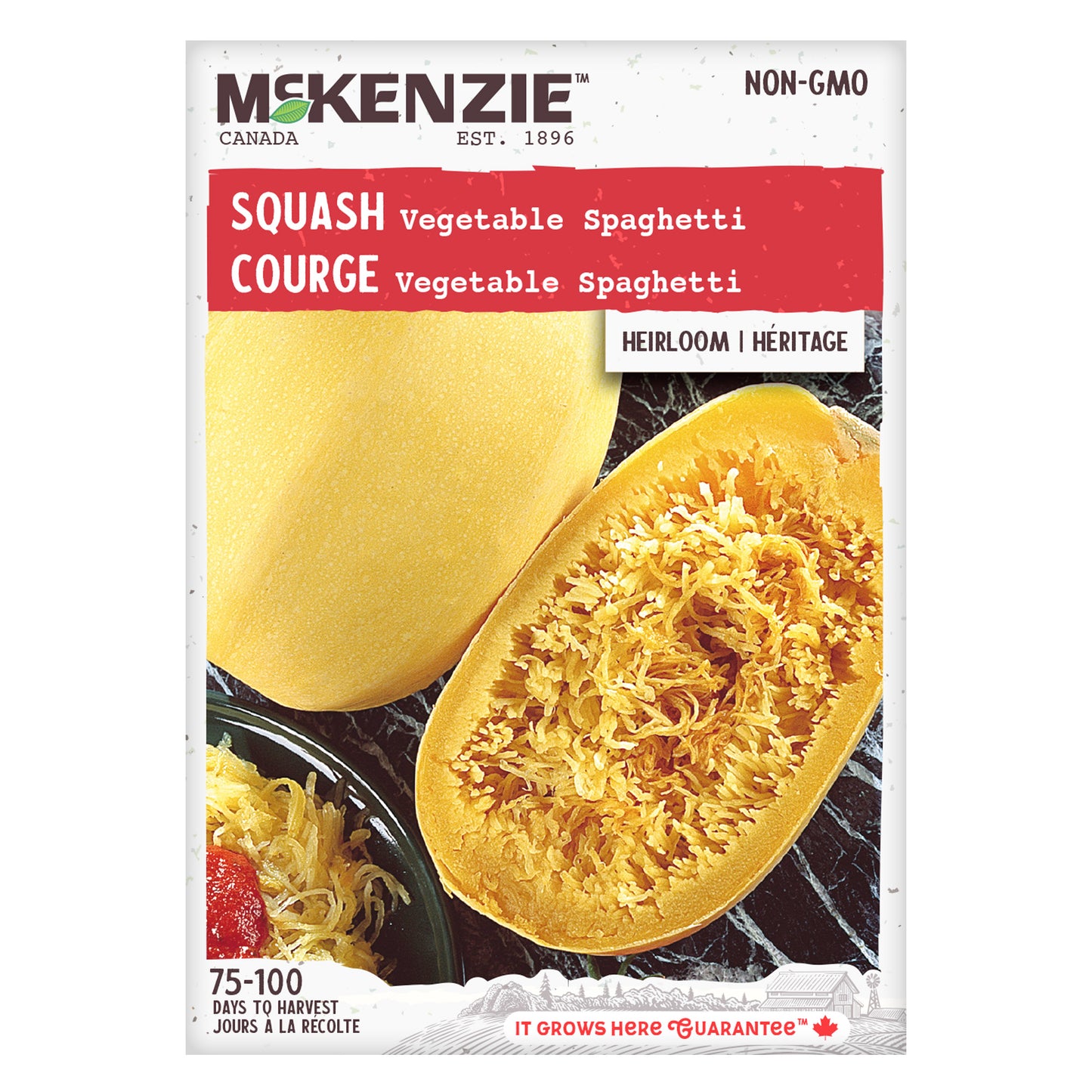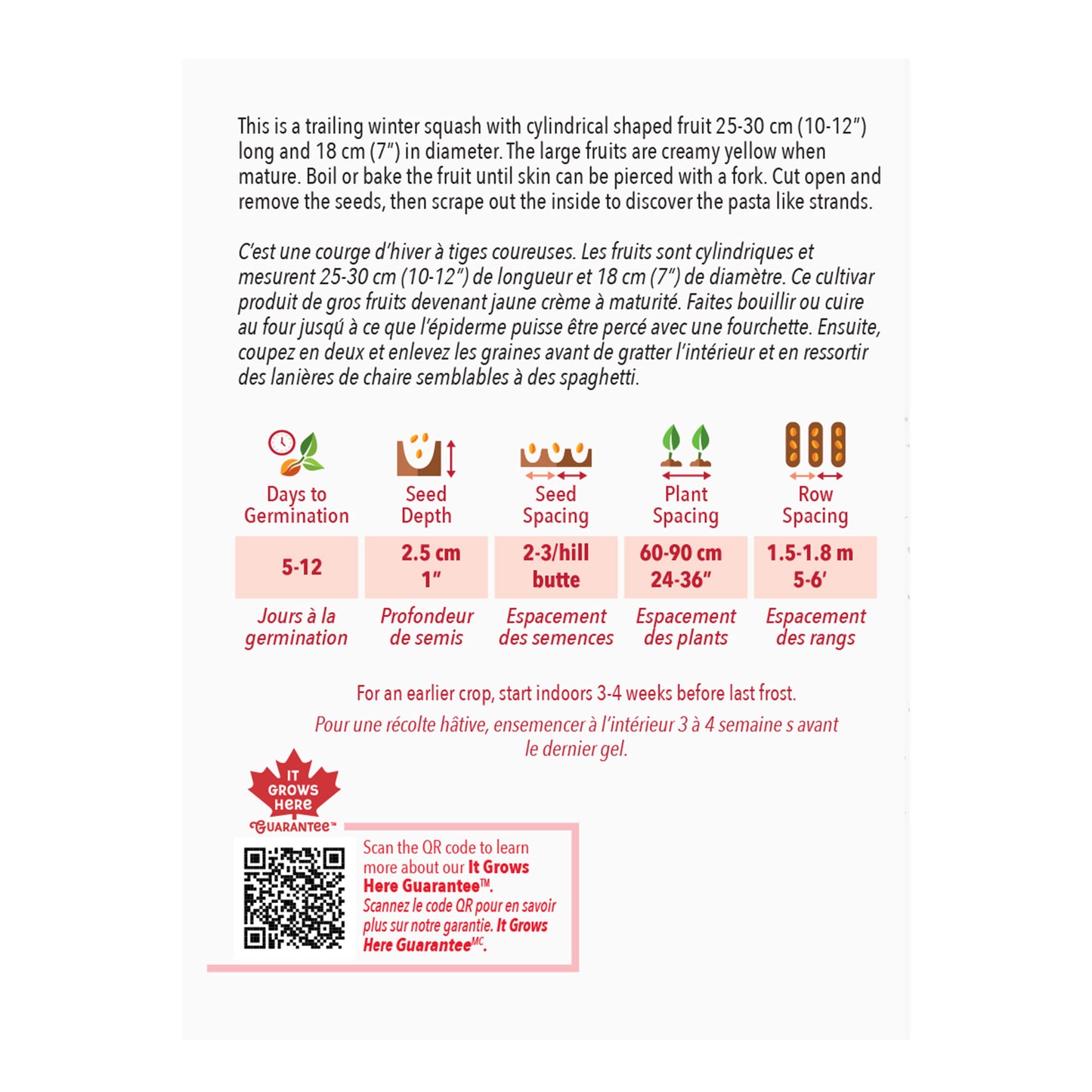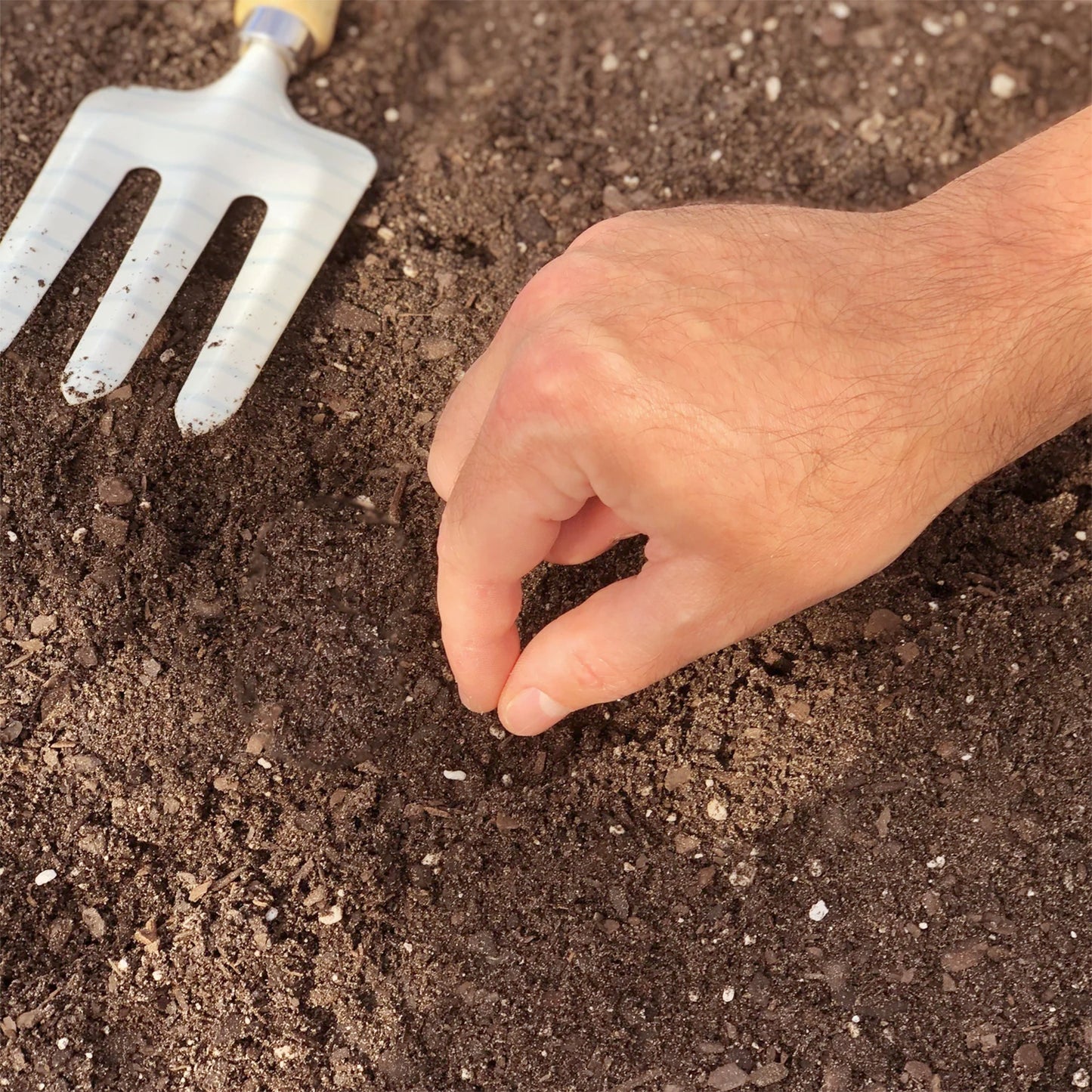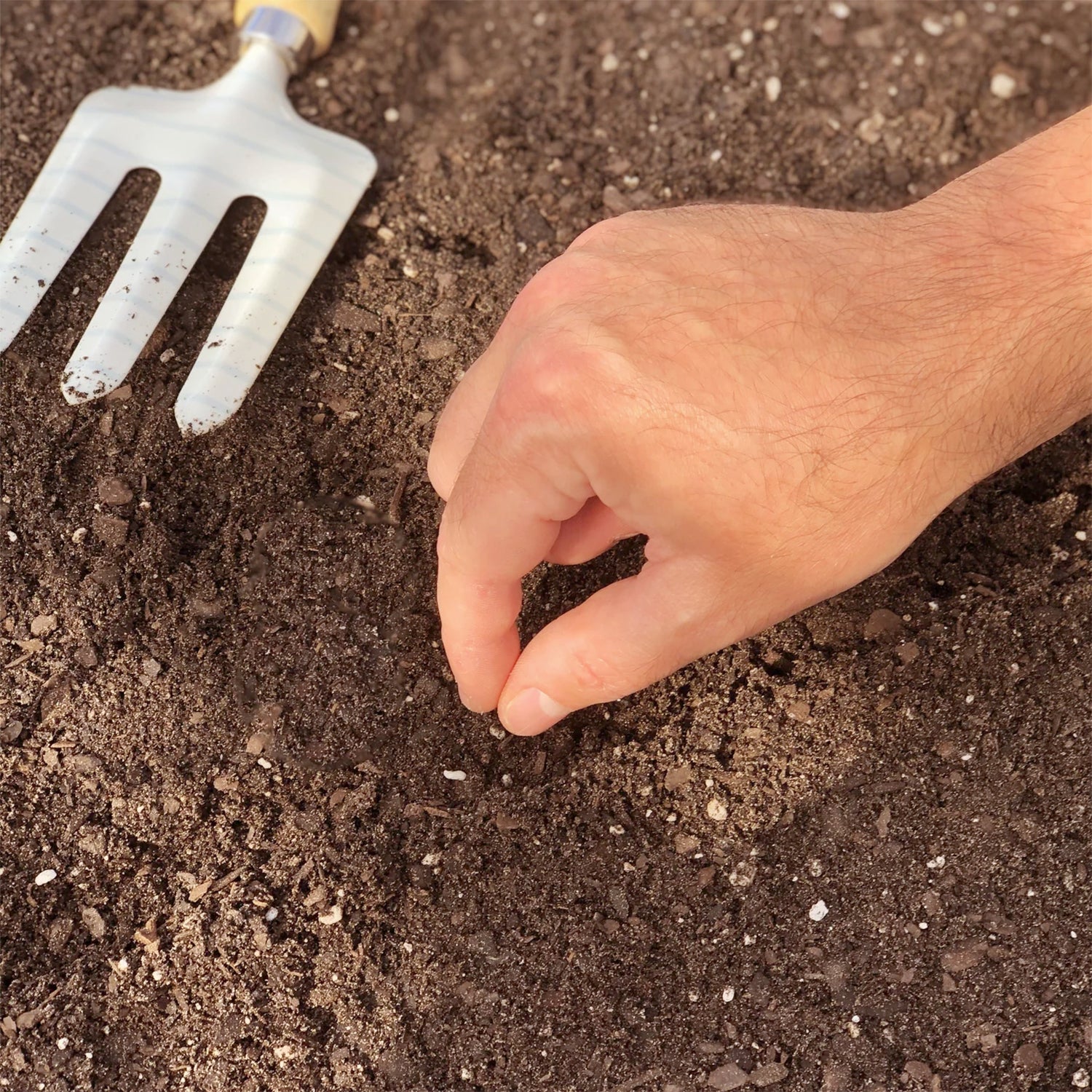10% Off E-Gift Cards With Promo Code | View All Offers >
Squash, Vegetable Spaghetti Seeds
Earn 3 points for this item with our
rewards program.

Grow your own delicious and nutritious spaghetti squash!
Vegetable Spaghetti Pasta squash is large and creamy yellow when mature. This winter squash grows cylindrical-shaped fruit 25-30 cm (10-12") long and 18 cm (7") in diameter on trailing vines. Cut open the squash, remove the seeds, then scrape out the inside to discover the pasta-like strands.
- SKU: 143810
- Common Name: Squash
- Botanical Name: Cucurbita pepo
Safe
for Bees
Grows
Best In:
Days to
Germination:
Water
Needs:
Days to
Maturity:
Best
Container Size:
Growing Height:
- Plant Type: Vegetable
- Plant Lifecycle: Annual (plant every year)
- Seed Type: Heirloom
- Fill Weight (grams): 3 g
- Approximate Seed Count: 15-20
- Planting Method: Direct Sow
- Water Needs: Moist 5 cm (2 in.) per week
- Landscape Use: Edible Garden
- Growth Habit: Winter
- Companion Planting:
Plant near pole beans, calendula, corn, marigolds, nasturtiums, oregano. Nasturtiums have the ability to shield against pumpkin and squash beetles. Oregano offers overall pest protection. Calendula acts as a deterrent for beetles and root nematodes. Squash is commonly planted alongside corn and beans, known as the "three sisters," to confuse the adult vine borer.
- Flavour: Chewy with a mild flavor
- Preparation Ideas: Preheat over to 400 F. Carefully cut the squash in half lengthwise. Use a spoon to scrape out the seeds and stringy bits of flesh. You do not want to remove any of the flesh. Place squash halves upside down in a backing dish. Add a little water to just cover the bottom of the backing dish. Roast the squash for 30 to 45 minutes, depending on the size of the squash. Remove from oven and turn the halves to flesh side up. The squash is ready when it is easy to shred the flesh into spaghetti like strands with the tines of a fork. You can do a taste test and if the strands are more crunchy then you prefer, place back in the oven for a while longer. If you prefer long spaghetti-like strands, rake your fork in the same direction as the strands. If desired, toss strands wtih butter or olive oil and salt and pepper.
Squash seeds can be sown directly in the garden when the soil is warm and all danger of frost is past and the soil has warmed. Soil temperature (not air temperature) should be between 15°- 21°C (60°- 70°F). Plant 2-3 seeds in mounds 1.5-1.8 m (5-6') apart. Press seeds into the soil to ensure good contact and cover with 2.5 cm (1 in.) of soil. After planting, water the seeds with a gentle mist or shower. It is critical to keep the soil consistently moist, but not soggy during germination. When your seedlings reach a height of a few centimetres (inches) and have developed 2 or 3 pairs of leaves, it is important to thin them out, according to the plant spacing indicated below. Do not allow the soil to become dry, as young plants have underdeveloped roots and can quickly dehydrate, particularly in windy conditions. For an earlier crop, squash seeds can be started indoors 3 to 4 weeks before the last frost in your area. Follow the seed depth and spacing guidelines indicated below. Once all danger of frost has passed, seedlings should be hardened off before planting in their growing location. Seedlings should be transplanted according to the plant and row spacing directions below. Regularly monitor your plants and ensure that the soil remains moist, but not soggy while they establish themselves in their new environment.
- Planting Depth: 2.5 cm (1in.)
- Seed Spacing: Sow 2 - 3 squash seeds per hill apart in rows, keeping rows approximately 1.5-1.8 m (5-6') apart.
- Plant Spacing: 60 - 90 cm (24-36 in.)
- Instructions for Nutrient Care: Apply SUPERThrive once per week. Soak in solution of 1/4 tsp per gal for 15 min. or longer depending on size and type.
- Use a row cover during the first few weeks of seedling growth to protect plants from insect pests. Remove covers before flowering to allow pollination by insects.
- Try to water plants at the base of the plant rather than overhead unless its a sunny day. Dampness on foliage and fruit invites rot and disease.
- Squash have shallow root systems and care should be taken when cultivating and weeding near the plants.
- Squash plants have distinct male and female flowers. The male flowers appear first on long, thin stalks, followed by the female flowers with an immature fruit at the bottom. For the female flowers to produce fruit, they require pollen from the male flowers to be transferred to them by bees.
- Poor pollination can result in squash flowers that do not bear fruit, or that bear small fruit. Consider growing bright-colored flowers nearby to attract pollinators.
- If you're growing squash with a bush or vining habit, its important to check for overcrowding and thin out a few lateral (non-main) stems or lower leaves (especially those touching the ground) to ensure better air circulation. This can help prevent the spread of disease like powdery mildew, reduce hiding spots for insect pests and make it easier for pollinators to find the flowers. Keep in mind that overcrowding can also cause weakened growth, so its important to leave enough leaves for the plant to produce food for itself. Don't prune more than 1/3 of the plant.
- An idicator that squash is ready to harvest is when th stem turns from green to brown woody stripes where it joins the fruit. When harvesting, cut the squash from the vines using a sharp knife or pruners. Avoid twisting or pulling fruits from the vines. Leave about 5-7 (2-3 in) of stem on each squash.




Squash, Vegetable Spaghetti Seeds
Register to receive a notification when this item comes back in stock.
Thanks! We'll let you know when this item is back in stock.
You may also like

Join our rewards program today to start saving!

Free Shipping on orders over $35

There are a ton of ways to earn!







